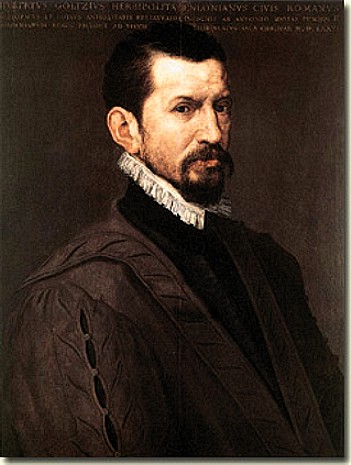Lessico
Hubert
Goltz
Hubertus Goltzius

Hubert Goltz (b Venlo, 30 Oct 1526 - d Bruges, 2 March 1583), Flemish humanist, printmaker, publisher, painter and numismatist. He was the son of Rutger den Meeler (Rutger van Weertsburg) and Catherina Goltzius, whose family name was taken by her husband. After studying in Venlo, Hubertus was sent to Luik (Liège) to the academy of Lambert Lombard, to whom he was apprenticed until 1546.
He then moved to Antwerp, where he became a member of the Guild of St Luke and took on Willem Smout as his pupil. Before 1550 Goltzius married Elisabeth Verhulst Bessemers, a painter from Mechelen, with whom he had four sons and three daughters. Her sister Mayken Verhulst was the second wife of Pieter Coecke van Aelst, which brought Goltzius into artistic circles.
Goltzius was active in Antwerp as a painter and antiques dealer, but the only painting that can be attributed to him with certainty is the Last Judgement (1557) for the town hall at Venlo. In Antwerp he was introduced by his friends to prominent numismatists, for whom he made drawings of coins and began a system of their classification. For the same purpose Goltzius undertook a study trip in 1556 through the Netherlands and the Rhine Valley.
The results of his investigations appeared in Vivae omnium fere imperatorum imagines (Antwerp, 1557), published by Gillis Coppens van Diest (fl 1543–73). The work was subsequently published in four other languages, the frontispiece in each edition, including the original, being printed in four different stages: one for the engraved text, two woodcut tone-blocks, and one woodcut key-block for the finer lines. Goltzius was apparently one of the first printers to combine woodcut and engraving in a single frontispiece. The copies of the imperial portraits published in the books are executed in a cameo technique.
www.artnet.com
In base alle ricerche di Lind![]() (1963) Hubert Goltz approntò anche
un’altra opera: Graecia, sive historiae urbium et populorum Graeciae ex
antiquis numismatibus restitutae libri quatuor etc. (Bruges, 1576). A Genova il 28 settembre 2001 si è
tenuta una conferenza sul libro antico che aveva per tema: “Un artista,
imprenditore e numismatico nell'Europa del '500: Hubertus Goltzius e la stampa
delle Icones Imperatorum Romanorum” - relatore:Christian E. Dekesel.
Ecco l’annuncio pubblicato nel web:
(1963) Hubert Goltz approntò anche
un’altra opera: Graecia, sive historiae urbium et populorum Graeciae ex
antiquis numismatibus restitutae libri quatuor etc. (Bruges, 1576). A Genova il 28 settembre 2001 si è
tenuta una conferenza sul libro antico che aveva per tema: “Un artista,
imprenditore e numismatico nell'Europa del '500: Hubertus Goltzius e la stampa
delle Icones Imperatorum Romanorum” - relatore:Christian E. Dekesel.
Ecco l’annuncio pubblicato nel web:
Hubertus Goltzius (Venlo 1526 - Bruges 1583), singolare figura di pittore, incisore, mercante e collezionista di antichità e monete, pubblicò nel 1557 ad Anversa le Icones Imperatorum Romanorum, un libro dedicato alle biografie di tutti gli imperatori, dall’antica Roma a Ferdinando I d’Asburgo, arricchito da raffinate incisioni colorate ispirate alle monete conservate nelle più note collezioni europee del tempo. Edita in latino e nelle principali lingue europee, nonostante i falsi e gli errori l’opera fu considerata per oltre due secoli un fondamentale e conosciutissimo manuale di riferimento per tutti gli studi di numismatica antica. La conferenza illustrerà le tappe più significative della vita di Hubertus Goltzius e si soffermerà sul caratteristico e innovativo metodo di incisione delle Icones ideato dall’artista fiammingo. Per l’occasione sarà visibile l’esemplare delle Icones posseduto dalla Biblioteca Universitaria di Genova.
www.csb-scpo.unige.it
Goltzius, Hubertus. C. Julius Caesar Historiae Imperatorum Caesarumque Romanorum Ex Antiquis Numismatibus Restitutae. Brughes, H. Goltzius, 1563. Bound with: Goltzius, Hubertus. Caesar Augustus Sive Historiae Imperatorum Caesarumque Romanorum Ex Antiquis Numismatibus Restitutae. Brughes, [H. Goltzius], 1574. 2 works in 1 volume. Folio (32 x 23 cm). - First editions of Goltzius' numismatic histories of Julius Caesar and Caesar Augustus. The splendidly engraved title-pages and the sober typography prompted De la Fontaine Verwey to rank these works among the most beautiful Dutch books of the sixteenth century (p. 86), praising their allure, majestic title-pages and excellent typography (p. 100). C. Julius Caesar was published in 1563, with 54 full-page engravings of ancient coins within ornamental frames and a history of the life of Caesar. The sequel appeared in 1574, Caesar Augustus. Slight waterstaining inner margin (in some parts) and outer margin throughout, some small corrosion spots, a few corrosion holes, not affecting text; a6 slightly soiled. Very good copy of these beautiful examples of sixteenth-century printing. Euro7500.
www.polybiblio.com